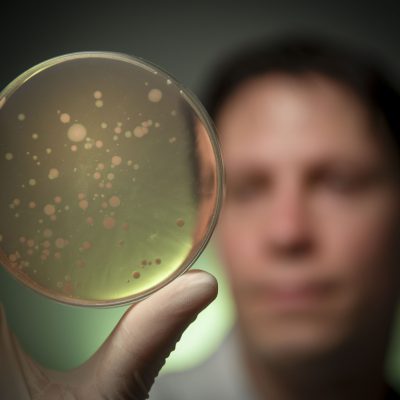Microbiome in health and disease
There are trillions of microbes living inside and on the surface of your body, altogether they are called the microbiome and are vital to your health and fighting disease.
Since the microbiome was first recognised in the late 1990s, scientists have identified more than 2,000 microbial species from the largest microbiome, in the gut. The skin, bladder and genitals also harbour microbiome populations.
While microbes are symbiotic (benefiting you and the microbes), and some are pathogenic (disease-causing), in a healthy person, the symbiotic and pathogenic microbes work in balance. Imbalances, known as dysbiosis, disrupt the microbes, making people more susceptible to conditions such as inflammatory bowel disease (IBD) and Clostridioides difficile infection, which causes severe diarrhea and inflammation of the colon or colitis.
Babies and the microbiome

Your microbiome starts at birth. Babies delivered naturally have a microbiome linked with their mother, whereas babies delivered by caesarean have more bacteria associated with hospital environments and are more likely to have antimicrobial resistance. While these differences largely even out by the time a baby is one year old, the first weeks of life are a critical window of development for a baby’s microbiome and immune system.
How do antibiotics affect your gut microbiome?

Antibiotics wipe out gut bacteria – killing the pathogen they are targeting and the beneficial bacteria too. This causes an imbalance in gut bacteria and means fewer beneficial bacteria are available to repopulate the gut faster, leading to further health issues. Resistance to antibiotics occurs when bacteria acquire changes in the gut and no longer respond to the antibiotic, making infections harder to treat and increasing the risk of disease, illness, and even death.
How does the gut microbiome affect your health?

Your gut microbiome composition is unique to you and effects your metabolism, gastrointestinal tract, brain, and immune system.
In addition to the microbiome, your gut also has a community of immune cells that help to repair tissues and defend against infection. Scientists do not yet know how the gut microbiome interacts with the gut’s immune cells, which immune cells co-exist with bacteria and why different diseases affect distinct areas of the gut. Hudson Institute scientists are working on the first detailed cell atlas of immune cells and gut bacteria within the human colon.
Adapting the microbiome to treat disease

The relationship between changes in microbiome and disease is still not clear. The challenge for scientists is to identify whether microbial imbalance is related to disease, and to be able to distinguish between cause and effect.
Scientists are now beginning to understand how the gut microbiome forms and changes, and how it can be used to help treat or even prevent disease. By rebalancing gut bacteria, microbiota-based medicines could help to treat a wide range of conditions like diabetes and obesity. There is hope that we may soon be on the cusp of a new era of healthcare that nurtures and tweaks the microbiome to optimise human health.
Our microbiome in health and disease research
Our scientists are at the forefront of understanding the complex microbiome communities. These answers will improve the understanding of why an illness develops and how best to treat it. The pioneering work of the Institute’s Synnate program is exploring new medical frontiers to answer how the innate immune system distinguishes ‘friend from foe’ and how these interactions control the immune system. In collaboration with commercial partners our scientists are developing microbial therapies to treat unmet medical need for patients with IBD.
Microbiome treatments for paediatric IBD


Clinical study. The involvement of gut bacteria in inflammatory bowel disease (IBD) has been known for decades. Several promising clinical studies have shown the microbiome could potentially be rebalanced in IBD using faecal transfer from healthy volunteers. However, there are no therapeutics for IBD that can be reproducibly supplied and administered to adult or child patients.
The Hudson Institute team working with Monash Health collaborators have identified key bacteria from the gastrointestinal tract for potential use as therapies in children with IBD. The project aim is to understand how these bacteria have their therapeutic effects in the gut and to use these bacteria in a Phase 1 clinical study of children with paediatric IBD.
Team | Associate Professor Samuel Forster, Dr Edward Giles, Dr Michelle Chonwerawong, Professor Paul Hertzog, Professor Elizabeth Hartland
Understanding human microbiome diversity

 Infrastructure building. Hudson Institute scientists have developed one of the most diverse collections of human-isolated bacteria in the world that is being used to understand how microbial communities develop, what factors can induce changes and what changes make humans susceptible to disease. These bacteria are available to support research activities through the Australian Microbiome Culture Collection.
Infrastructure building. Hudson Institute scientists have developed one of the most diverse collections of human-isolated bacteria in the world that is being used to understand how microbial communities develop, what factors can induce changes and what changes make humans susceptible to disease. These bacteria are available to support research activities through the Australian Microbiome Culture Collection.
Team | Associate Professor Samuel Forster, Dr Emily Gulliver
Understanding the origins of gut health

 Clinical study. When gut bacteria become unbalanced, they provide a potential environment for inflammation and diseases such as inflammatory bowel disease, Clostridium difficile infection and gastrointestinal cancer.
Clinical study. When gut bacteria become unbalanced, they provide a potential environment for inflammation and diseases such as inflammatory bowel disease, Clostridium difficile infection and gastrointestinal cancer.
In babies, Dr Sam Forster and his team are studying how healthy gut bacteria establishes in the gastrointestinal tract after birth and the factors modulating proliferating species.
Team | Associate Professor Samuel Forster, Professor Marcel Nold, Professor Claudia Nold
Understanding the role of prebiotics and probiotics on the microbiome


Clinical studies. Diet, lifestyle and medications such as antibiotics play a critical role in determining the composition of the gut microbiome. The team is studying the effect of antibiotics and probiotics on the gut microbiome through the PAPRIKA clinical trial. This work aims to understand the disruptive effects of post-surgery antibiotics on the microbiome and the role prebiotics and probiotics could play in restoring the natural microbiome.
Team | Dr Emily Gulliver, Associate Professor Samuel Forster
Characterising the food microbiome and its roles on microbiome diversity

 Clinical study. Scientists have demonstrated that the human diet contains numerous live bacteria from a diverse array of species that colonise the human gastrointestinal tract.
Clinical study. Scientists have demonstrated that the human diet contains numerous live bacteria from a diverse array of species that colonise the human gastrointestinal tract.
By understanding the effect these regular bacterial arrivals have on the gut microbiome, Dr Sam Forster’s team are looking at opportunities to extend current dietary interventions to include direct introduction of bacteria and targeted microbiome remodelling to optimise gut health.
Team | Associate Professor Samuel Forster
Microbiome in health and disease news
Microbiome in health and disease collaborators
Keep up-to-date with our latest discoveries















 Clinical study. When gut bacteria become unbalanced, they provide a potential environment for inflammation and diseases such as inflammatory bowel disease, Clostridium difficile infection and gastrointestinal cancer.
Clinical study. When gut bacteria become unbalanced, they provide a potential environment for inflammation and diseases such as inflammatory bowel disease, Clostridium difficile infection and gastrointestinal cancer.
